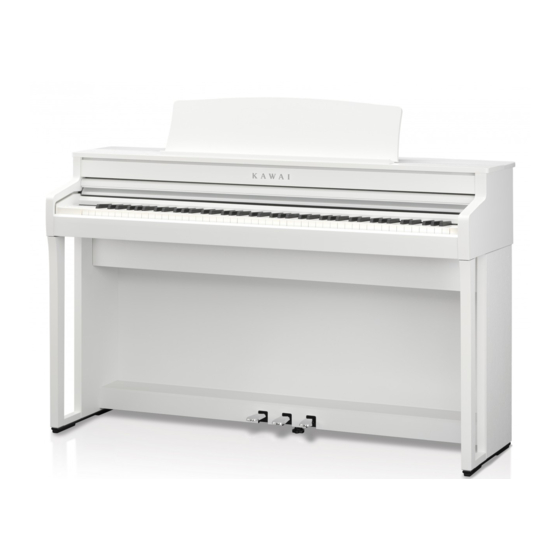
Advertisement
CA59 MIDI Settings Manual
MIDI Settings
MIDI Overview
The term MIDI is an acronym for Musical Instrument Digital Interface, an international standard for connecting
musical instruments, computers, and other devices to allow the exchange of performance data.
MIDI Terminals
The MIDI has two types of terminals: MIDI IN and MIDI OUT. These terminals must be connected via dedicated cables.
MIDI terminal
MIDI IN
MIDI OUT
MIDI channels
MIDI uses channels to exchange data back and forth between MIDI devices. There are receive (MIDI IN) and transmit (MIDI OUT)
channels. Most musical instruments or devices with MIDI functions are equipped with both MIDI IN and OUT jacks and are capable of
transmitting and receiving data via MIDI. The receive channels are used to receive data from another MIDI device, and the transmit
channels are used to transmit data to another MIDI device.
The illustration below shows three musical instruments, connected together using MIDI.
Transmitting instrument a
Transmitting instrument a sends transmit channel and keyboard information to receiving instruments b/c.
The information arrives at the receiving instruments b/c.
Receiving instruments b/c will respond to MIDI data that is sent if their receive channel is the same as the transmit channel of the
transmitting instrument a. If the channels do not match, the receiving instruments b/c will not respond to any data that is sent.
For both receiving and transmitting, channels 1-16 can be used.
Recording/playing with a sequencer
When connected to a sequencer (or a computer running MIDI
sequencing software), the CA59 digital piano can be used to
record and playback multi-track songs, with separate sounds
playing simultaneously on each channel.
Function
Receiving note, program change, and other data.
Sending note, program change, and other data.
Receiving instrument b
1
Receiving instrument c
Sequencer
Advertisement
Table of Contents

Summary of Contents for Kawai CA59
- Page 1 For both receiving and transmitting, channels 1-16 can be used. Recording/playing with a sequencer When connected to a sequencer (or a computer running MIDI sequencing software), the CA59 digital piano can be used to record and playback multi-track songs, with separate sounds playing simultaneously on each channel.
- Page 2 * Please refer to the “MIDI Implementation Chart” on page 10 for further Multi-timbral mode setting information regarding the MIDI capabilities of the CA59 digital piano. Receive multiple channel MIDI data from a MIDI-connected musical instrument or device.
-
Page 3: Midi Channel
Omni mode When the CA59 digital piano is turned on, the instrument is automatically set to “omni mode on”, allowing MIDI information to be received on all MIDI channels (1~16). When the MIDI Channel setting is used to specify a transmit/receive channel, the instrument will be set to “omni mode off”. - Page 4 CA59 MIDI Settings Manual MIDI Settings Send Program Change Number The Send Program Change Number function is used to send a Program Change Number (1-128) to the connected MIDI device. 1. Selecting the Send Program Change Number function After entering the MIDI Settings menu (page 2): Press the ...
-
Page 5: Local Control
The Local Control setting determines whether the instrument will play an internal sound when the keys are pressed. This setting may be useful when using the CA59 digital piano to control an external MIDI device that is connected to the instrument’s amplifier/speakers. - Page 6 CA59 MIDI Settings Manual MIDI Settings Transmit Program Change Numbers The Transmit Program Change Numbers setting determines whether the CA59 digital piano will transmit program change information via MIDI when the instrument’s panel buttons are pressed. Transmit Program Change Numbers setting...
- Page 7 MIDI Settings Multi-timbral Mode The Multi-timbral Mode setting determines whether or not the CA59 digital piano is able to receive MIDI information on more than one MIDI channel simultaneously. This allows the instrument to play back multi-track, multi-timbral performance data sent from an external MIDI device.
-
Page 8: Channel Mute
Memory for convenient recall, or to the Startup Setting memory for automatic selection when the instrument is turned on. Please refer to CA59 Owner’s Manual pages 35 and 77 for more information. 3. Exiting the Channel Mute function Press the FUNCTION button (BACK) to exit the Channel Mute adjustment screen and return to the MIDI Settings menu. - Page 9 CA59 MIDI Settings Manual Program Change Number List Multi-timbral mode = off/on1 Multi-timbral mode = on2 Sound Name Program Number Program Number Bank MSB Bank LSB Piano 1 SK ConcertGrand EX ConcertGrand SK-5 GrandPiano Jazz Grand Mellow Grand Mellow Grand 2...
-
Page 10: Midi Implementation Chart
CA59 MIDI Settings Manual MIDI Implementation Chart [DIGITAL PIANO] Date: May 2020 MIDI Implementation Chart Kawai CA59 Version: 1.0 Function Transmitted Section Remarks Default 1 - 16 1 - 16 Basic Channel Changed 1 - 16 1 - 16 Default...






Need help?
Do you have a question about the CA59 and is the answer not in the manual?
Questions and answers